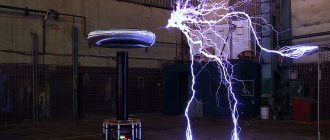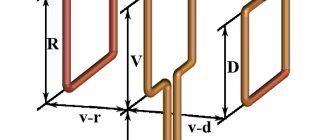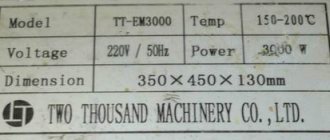In modern conditions, the cost of energy resources is constantly increasing, forcing many people to live in austerity mode. In this regard, alternative sources of electricity are becoming increasingly popular. Various methods are being invented, including exotic ones. Attempts are being made to get electricity from the ground, completely free of charge. In order to distinguish reality from fiction, you should carefully study the arguments of experts and the results of practical experiments conducted by enthusiasts in this field.
Why extract electricity from the ground?
In order to generate electricity, you need to find a potential difference and a conductor.
By connecting everything into a single flow, you can provide yourself with a constant source of electricity. However, in reality, taming the potential difference is not so simple. Nature conducts enormous power of electricity through a liquid medium. These are lightning discharges, which are known to occur in air saturated with moisture. However, these are just single discharges, and not a constant flow of electricity.
Man took on the function of natural power and organized the movement of electricity through wires. However, this is just a transfer of one type of energy to another. Extracting electricity directly from the environment remains mainly at the level of scientific research, experiments in the category of entertaining physics and the creation of small low-power installations.
The easiest way to extract electricity is from a solid and moist environment.
Is it possible?
Before we consider technological schemes and answer the question “how to get electricity from the soil?”, Let’s figure out how realistic this is.
It is believed that there is a lot of energy in the earth and if you make an installation, you will forever use it for free. This is not true, because in order to receive energy you need a certain piece of land and metal pins that you install in it. But the pins will oxidize and sooner or later the energy intake will end. In addition, its quantity depends on the composition and quality of the soil itself.
To achieve good power you need a very large area of land, so in most cases the energy obtained from the ground is enough to turn on a couple of LEDs or a small light bulb.
It follows from this that it is possible to obtain energy from the earth, but it is unlikely to be used as an alternative to power grids.
Unity of three environments
The most popular medium in this case is soil. The fact is that the earth is the unity of three media: solid, liquid and gaseous. Between small particles of minerals there are drops of water and air bubbles. Moreover, the elementary unit of soil - a micelle or clay-humus complex - is a complex system with a difference in potential.
A negative charge is formed on the outer shell of such a system, and a positive charge on the inner shell. The negatively charged shell of the micelle attracts positively charged ions in the medium. So electrical and electrochemical processes are constantly occurring in the soil. In a more homogeneous air and water environment, there are no such conditions for the concentration of electricity.
Large scale power generation
In the twentieth century, the largest percentage of electrical energy production came from thermal power plants and combined heat and power plants. With the development of nuclear energy, the global share of electricity production at nuclear power plants exceeded 10%. The construction of hydroelectric power stations is limited by several natural factors, and therefore the hydroelectric conversion method is used locally, with reference to lowland rivers. Completely environmentally friendly electricity or “green megawatts” - the products of alternative generation facilities - is gaining popularity in the 21st century, which is associated with concern for the environment and the desire to rationally use natural resources.
TPP
Thermal power plants have become popular due to the relatively low costs to reach their designed capacity. The construction of thermal power plants is not associated with the creation of dams and the installation of nuclear reactors. To convert the energy potential of hydrocarbons into electricity, a technological system consisting of steam boilers, a steam pipeline and turbogenerators is required. The scale and schemes may be different, including in combination with a heating plant, but the basic operating principle of thermal power plants is the same for all cases: the heat from combustion is converted into electrical voltage through intermediate vaporization.
GRES
Hydroelectric power plants, unlike thermal power plants, do not require fuel, remove solid waste (coal, peat, shale thermal power plants) and do not pollute the atmosphere with combustion products. But at latitudes with cold winters and freezing reservoirs, the performance of state district power plants depends on seasonal factors. The costs invested in the construction of dams take a long time to pay off, and the destruction of arable land as a result of flooding requires a careful assessment of how feasible it is to build hydraulic structures in a certain region.
NPP
Nuclear power plants convert energy from nuclear decay into electricity. Heat from the reactor is absorbed by the primary circuit coolant and heated through a water steam generator in the second circuit, from where the steam is supplied to the generator turbines - and rotates them. The complexity of the process and the danger associated with emergency situations limit the spread of this type of production. The operation of the reactor must be controlled by modern technologies, and the spent fuel must be disposed of in compliance with protective measures.
January 26, 2018
Share the link with your friends:
Method 1 - Neutral wire -> load -> soil
Voltage is supplied to residential premises through 2 conductors: phase and neutral. When creating a third, grounded conductor, a voltage of 10 to 20 V arises between it and the zero contact. This voltage is enough to light a couple of light bulbs.
Thus, to connect electricity consumers to “ground” electricity, it is enough to create a circuit: neutral wire - load - soil. Craftsmen can improve this primitive circuit and obtain a higher voltage current.
How to get free 220 volts
Today, together with the do-it-yourself channel, we will make free lighting in the utility room. The task is not easy, almost impossible - to get 220 volts for free.
First, we will make grounding connections from metal pins. Let's weld the bolts, sharpen them, and connect them to the wire. The pins were sharpened diagonally so that they fit well into the ground. Let's score. Pay special attention to grounding. It must be very good. A thick wire was connected to four pieces of metal, which will go into the room. The wire goes inside.
Now we will make 0. To do this, we will connect to the nearest outlet, but always to the zero contact. It is legal. The connection must be made with the electricity turned off to avoid electric shock. We installed a white wire in the room where the lighting will be provided. So, there are two wires: ground and zero. It would seem that there should be no electric current here. But this is a misconception. Let's take a multimeter and set it to AC. Let's take the readings. The device showed 3 volts. You might think that this is very little. Do a little trick. We connect these wires to the transformer. It was 220 by 6. The master remade it and removed some of the windings. Now it is 220 at 3 volts. Stand on the side where 3 volts are connected, connect 0. Now grounding. Let's measure again. The device is also set to receive AC readings. Almost 100 volts. By the way, there is a noticeable electric shock. Take an LED light bulb. 220 volts, 3 watts. Let's connect. The light has appeared!
Method 2 - Zinc and copper electrode
The next method of generating electricity is based on using only land. Two metal rods are taken - one zinc, the other copper, and placed in the ground. It is better if it is soil in an isolated space.
Isolation is necessary in order to create an environment with high salinity, which is incompatible with life - nothing will grow in such soil. The rods will create a potential difference, and the soil will become an electrolyte.
In the simplest version, we get a voltage of 3 V. This, of course, is not enough for a home, but the system can be complicated, thereby increasing the power.
What else?
Among the usual ones, you can also find quite unusual ways of generating electricity. Recently, scientists around the world have been intensively working on the development of alternative energy. The world is looking for opportunities for its wider use.
Below is a short overview of the best methods and ideas:
Thermal generator – converts thermal energy into electrical energy. Built into heating and cooking stoves.
Piezoelectric generator – works on kinetic energy. They are introducing dance floors, turnstiles, and exercise equipment.
Nanogenerator - uses the energy of vibrations of the human body during movement. The process is instantaneous. Scientists are working on combining the work of a nanogenerator and a solar battery.
Experimental installations that operate on ether - electromagnetic field. While the search is still underway, hypotheses are being tested, experiments are being conducted.
Scientists have calculated that the natural reserves used in modern energy may last for another 60 years. The best minds are working on developments in this area. In Denmark, the population relies on wind energy for 25%.
In Russia, projects are planned to use renewable sources in the energy system by 10%, and in Australia by 8%. In Switzerland, the majority voted for a complete transition to alternative energy. The world votes yes!
Features of electrical installation
If everything is more or less clear with the sources, we move on to the rules for arranging the electrical network itself:
Electrical panel installation
- The installation of wiring and electrical appliances in a country house can be done with your own hands, but it is better to entrust the connection to the main line or generator to specialist electricians.
- We must install a sign with a meter at the entrance to the house. We also connect each branch of wires to the panel through an RCD - an automatic circuit breaker. The use of such fuses can protect the system from voltage surges and short circuits.
Advice! If you are often away, then it makes sense to set up remote switching on of electricity at your dacha. To do this, we install a special module with a GSM receiver in the panel, which activates the entire system based on a signal from a mobile phone. It is especially convenient to use such a controlled unit in winter: by the time you arrive, the heating devices will have time to warm up the air.
To protect against fire, we lay wires in non-flammable channels
- When using generators, you need to carefully calculate the power of all devices connected to the network. For example, heating a country house with electricity may require the installation of a separate generating unit, otherwise in the fall and winter we will have to choose: either our batteries work or the light bulbs shine.
- Country houses made from block containers, frame structures and log buildings are highly flammable. To reduce the risk of fire, all wiring should be laid in non-flammable, preferably metal, boxes.
Proper grounding is one of the safety conditions
- It is also highly desirable to ground the wires. To do this, we connect each branch of the system to a grounding circuit brought out. The circuit most often consists of a triangle of steel or copper-plated rods dug into the ground and connected to the house electrical network by a conductive cable.
Solar panels
Alternative electricity from the sun is rarely used in private housing construction. It's all about the high cost of solar cells that are installed in batteries. Hence the high cost of the entire installation. Although it should be noted that this is a promising direction that cannot be abandoned. After all, every year 1000 kW of energy falls on one square meter of the earth’s surface. Imagine how much humanity is losing. If we compare it with other types of fuel, this is 100 m³ of gas or 100 liters of diesel fuel.
Of course, obtaining electric current in this way is still expensive. But heating water this way is very cheap. That is why solar collectors are so in demand today among residents of suburban villages.
Alternative
In 1901, the famous, brilliant scientist Nikolai Tesla designed the huge Wardenclyffe Tower in New York. JP Morgan took over the financial part of the project. Tesla wanted to implement free radio communications and provide humanity with free electricity. Morgan was simply expecting wireless international communications.
The idea of free electricity horrified the industrial and financial “Aces”. There were no willing revolutions in the world economy; everyone was holding on to super-profits. Therefore, the project was canceled.
So what did Tesla build? How was he going to make free electricity? In the 21st century, the idea of alternative energy powered by other sources is gaining increasing support. A kind of opponent to oil, coal, and gas here are the renewable resources of the Earth and other planets.
Where can you get free electricity from? Sunlight, wind energy, earth energy, the use of tides, and the muscular energy of the human body can change the future of the planet. Pipelines and reactor sarcophagi will become a thing of the past. Many states will be able to free their economies from the need to purchase expensive sources of electricity.
Lighting using a wind generator
For autonomous lighting of the garage, you can use a homemade wind generator. Such a windmill will also generate free electricity, which can be used to power a 12-volt lamp.
Note! You can either make a windmill yourself or buy a ready-made device. However, a purchased wind generator will cost a pretty penny.
Homemade wind generator
When creating this type of lighting, wind speed must be taken into account. In a situation where strong winds are rare in the area of residence, then this method of lighting will be ineffective. Here, all the costs that went into installing a wind generator will not pay off.
Making a bed: step-by-step instructions and video
Further actions consist of manufacturing the support unit (frame), installing the working equipment, connecting it to the electric motor and direct commissioning. The sequence of actions is as follows:
- First you need to make a frame, which can be cut from steel pipes (profiles) in accordance with the dimensions in the drawings. All joints must be made only at right angles, so you can check the correctness of the connection using a regular square. The bed is made of guides. which can be used as long shafts.
The side posts of the frame should be given special attention, since they are load-bearing elements. Consequently, the immobility of the entire structure largely depends on them
It is best to make the stands on a professional lathe.
Next, you need to assemble the entire support installation: the side elements go along the edges, between them there are 2 guides. Bushings are mounted on the guides at a certain interval, as shown in the photo.
Next, the bushings are fixed, with the help of which the tailstock and tool holder will be attached. In this case, it is better to make sure that the bushings are of different sizes, since the movement of the mechanism in this case will be greater.
The surfaces for mounting the caliper are made of ordinary steel sheets
It is important that they are free from defects and even. The optimal sheet thickness is within a centimeter.
Next, the lead screw is installed. You can make a carving on a metal stick, but there are simpler options - for example, use the leg from an old swivel chair
When installing the screw, it is important to ensure that the side posts are equipped with bushings. A steering wheel is attached to the propeller itself to allow rotation, as well as a vernier.
After this, the surface is mounted on which the headstock will then be installed.
After this, the frame is completely assembled
It is important to take into account that all elements are tightly connected - the slightest slack is unacceptable, since during operation vibration swings will increase the fragility of the mechanism and can lead to damage.
Visual instructions for installing the frame are in this video.
Stephen Mark Generator
Using this device, you can accumulate a certain electrical potential to service household appliances without using additional recharge. The technology was patented, resulting in hundreds of enthusiasts trying to replicate the experience at home. However, due to its specific features, it was not possible to release it to the masses.
The operation of the Steven Mark generator is carried out according to a simple principle: in the ring of the device, a resonance of currents and magnetic vortices are formed, which cause the appearance of current shocks. To create a toroidal generator you need to follow the following instructions:
- First of all, you should prepare the base of the device. You can use a ring-shaped piece of plywood, a piece of rubber or polyurethane. You also need to find two collector coils and control coils. Depending on the drawing, the dimensions of the structure may differ, but the optimal option is the following indicators: the outer diameter of the ring is 230 mm, the inner diameter is 180 mm. The width is 25 mm, the thickness is 5 mm.
- It is necessary to wind the internal collector coil using stranded copper wire. For better interaction, a three-turn winding is used, although experts are confident that one turn can power a light bulb.
- You should also prepare 4 control coils. When placing these elements, you must maintain a right angle, otherwise interference with the magnetic field may occur. The winding of these coils is flat, and the gap between the turns is no more than 15 mm.
- When winding control coils, it is customary to use single-core wires.
- To install the last coil, you should use insulated copper wire, which is wound over the entire base area of the structure.
https://youtube.com/watch?v=hIfQjh6DlAI
Galvanic cell
The next method is simple chemistry. This is the most realistic and understandable way to generate electricity from the ground at home. For this you need copper and zinc electrodes. Their role can be plates, pins, nails. If copper is common, problems with zinc may arise, so it is easier to find galvanized iron.
You need to drive your electrodes into the ground at the same distance from each other. Let's say 1 meter deep and 0.5 meters between the electrodes. In this case, copper will be the cathode and zinc will be the anode. The voltage of such an element can be of the order of 1-1.1 Volts. This means that in order to get 12 volt electricity from the ground, you need to drive 12 such electrodes and connect them in series.
The decisive factor in such a battery is the area of the electrodes; the current strength depends on this, as well as on what is located between them. In order for the battery to produce current, the ground must be moist, for this it can be watered, sometimes the zinc electrode is filled with a solution of salt or alkali. To increase the current output, you can pack more electrodes and connect them in parallel. All modern batteries and accumulators are designed this way.
In the diagram below you see another interesting implementation of such a battery made of copper pipes and galvanized rods.
However, over time, the electrodes will deteriorate and the battery will gradually stop working.
Fuel Generator Sets
Generators running on liquid or gaseous fuel (gasoline, diesel fuel, gas) can become a backup source of electricity.
Everything is simple here: the installation consists of an internal combustion engine and a generator. The engine turns the rotor and the generator produces energy.
Such a system cannot be called completely autonomous; it still requires fuel, which is also constantly becoming more expensive. But as a backup source of electricity, such generator sets are the most optimal.
If the weather has been cloudy for several days or there is no wind, you can always start the generator set to replenish the battery charge.
Among the positive qualities of fuel-powered generator sets is the constant availability of electricity, such plants are relatively cheap, and they provide a good energy output.
Their disadvantages include the need for fuel, which ensures constant costs. Such installations cannot operate for a long period, and internal combustion engines require maintenance.
Also, to use generator sets, it is necessary to allocate a separate room and organize the removal of exhaust gases, and, of course, there can be no question of any environmental friendliness.
Options for autonomous garage lighting
As already mentioned, the best choice for any garage structures will be LEDs. They have a lot of advantages, among which the following points should be highlighted:
- creating uniform and bright lighting;
- in terms of glow intensity, such a lamp creates a luminous flux that is equal to daylight;
- economical consumption of electricity;
- such lighting devices can be powered from various devices (for example, from a battery) in a situation where there is no source of electricity.
LED Garage Lighting
Most often, 12-volt LED strips are used to illuminate garage spaces. With its help, you can create general lighting by running a ribbon around the perimeter of the structure. In such a situation, the light emanating from the tape will fall evenly. Using an LED strip, you can also create local illumination of shelves and racks, as well as an inspection pit.
Note! To illuminate the inspection pit, a lamp or LED strip must be purchased with a high moisture resistance class. This is due to the fact that there is always high humidity here due to poor ventilation and lack of heating.
The same conditions and requirements are typical for the basement. In this regard, the lighting installation that will be used here should not have a power higher than 12 volts. You need to remember that in certain places in the garage you need to install a waterproof lamp, both when creating autonomous lighting and when electricity is available.
Grounding
With the help of a grounding loop, the potential of the protective PE conductor, and therefore the housing of all equipment connected to the electrical circuit, will be equal to the ground potential. This is why it is important to monitor the resistance of the ground circuit. According to the rules, it should not exceed 4 ohms. The grounding device diagram is shown in Fig. 2. Grounding consists of a grounding conductor and a grounding conductor.
Figure 3. Grounding device diagram
A ground electrode is a metal conductor in direct contact with the ground. A grounding conductor is a metal conductor that connects the PE bus of the input panel to the ground electrode.











